Thursday, September 22, 2011
Trapped in the Champlain Canal: Locks 12 and 11: The Sea Stooges biggest blunder
September 6 – 10, 2011
In the chronological order of the blog, by date, I wrote that we had gone all the way to the southern end of Lake Champlain and had wanted to lock through Lock 12 to get into the Champlain Canal. However, Lock 12 was closed. It's time for an overview of the Champlain Canal.
Completed in 1822, the Champlain Canal connects the Hudson River to Lake Champlain to supply controllable water depths for waterway traffic, a distance of about 60 miles. The Canal travels uphill from its southern end for Locks 1 – 8, and then goes downhill from Locks 9 – 12 (there is no lock 10). There are several rivers and creeks that feed into the Canal which play a role in its ability to remain operational. 27 fixed bridges cross over the Canal, with a minimum clearance height of 17'. If the water is high, like from Irene, the bridge clearance height is reduced, and for us, that is the difference between moving or staying tied to a wall and waiting for the water level to drop down.
Irene and Lee, bringing extensive amounts of rain and runoff, caused many problems to the Canal system. Locks were damaged by flooding, causing some issues with their electrical operation. Debris, including full-sized trees, interfered with the lock gates opening properly. Navigational aids on the Hudson River portion of the Canal below Lock 7 were moved or torn out of place. Excessive waterflow over the dams located adjacent to the locks caused dangerous currents which made it unsafe to open the locks or to allow cruising boats to remain in the area. The Federal Lock in Troy, and several of the lower locks on the Champlain Canal had not operated since August 28.
So, when we arrived at Lock 12 it couldn't be opened because so much water was flowing over the dam, creating a suction effect on the lock adjacent to it, and the lock gate could not be safely opened.
Two marinas are right outside of Lock 12. Whitehall Marina suffered extensive damage to their docks when the hay bales went over the dam and hit the docks, taking several downstream. We could tell just by looking that there was no where for FLUKE.
We called Lock 12 Marina, and they had a space big enough for FLUKE. The main building was used as an ammunition warehouse for the U.S. Navy during the War of 1812. The town of Whitehall, NY is located right on the other side of the lock and touts itself as the birthplace of the U.S. Navy. Sadly, we would not get to visit the little town.
I think we were put on some kind of “annex “ dock since it was cockeyed and offset from the main section. A partially submerged wooden ramp allowed us to get out on the part we were tied to. They only had 30 AMP power, so we couldn't use that and had to run our generator. The potable water line had been damaged by the storm event, so we couldn't top off our tanks, and we were low on water. However, we still had to pay $96 for the night.
I saw this sign on the lower portion of the building. Since we couldn't get any water, I was wondering if this was a joke or not!
As soon as we were tied up, Wayne and I put on our raingear and walked up through town and over the bridge to the lockhouse to talk to lockmaster Bill to find out what was going on with Lock 12. He explained how the water going over the dam created the suction problem on the gate's ability to operate. The dam at Lock 12, unlike the others on the this side of the system, has controllable flow gates. If the dam gates are closed, water can be held back to an appropriate level in the Canal. The other dams just let excess water flow over with no control gates. He told us to check again in the morning and see if he was permitted to open the lock based on the flow going over the dam.
When morning came, we put on our raingear again and went to talk to Bill. He said, as we were speaking, Lock 12 was open and we could go through. We told him it would take 20 minutes for us to get back to FLUKE, but that we would want to lock through and tie up on the wall above the lock.
Bill opened the lock for us, but said he had no idea how long it would remain open. If he had to open more gates on the dam, he said that we would have to move up to Lock 11 where we would be safer from the rising water. At around 4:00 p.m., Bill knocked on the boat and said he would be opening more of the dam and we needed to move.
It was raining, and Eddie and Wayne needed to take off the ladder that goes to the roof of the pilothouse, since we knew that some of the bridge clearances were going to be too close for us to clear safely. Removing the ladder, gave us 16'9'', not much room for error, and certainly not enough to clear the bridges further on which required 17' at normal water. At least we could make it to Lock 11 though.
We slowly pulled up to the first bridge, taking the boat out of gear just to coast under or be able to reverse the engine if it looked like we wouldn't be able to clear with the satellite dome and search light still on the roof. Eddie stood up in the center back to see if it looked like we could clear. It was apparent that the bridge height measurement doesn't include anything hanging off the bottom of the bridge like lights, pipes, or brackets, so you have to make sure to dodge those things.
Just as we were easing under the first bridge, we heard an awful LOUD scraping and splintering sound, following by a crashing sound coming from the back deck. We thought Eddie had fallen off the stool he was standing on. Glancing out the back windows we saw that both the VHF and the single side band antennas had not been lowered. They had both been shattered in half, bringing parts of the rusty underside of the bridge down with all the splintered fiberglass from the antennas.
We had established a “procedure” that said whoever put up the antennas was supposed to pull the key out of the ignition and put a card on the helm that says “Antennas up”. Eddie had put up the antennas so there was more room to walk around the back deck, but he never pulled the key or put up the card. I was so angry I didn't go out on the back deck for 2 days because I just couldn't stand to look at the broken antennas. This also presented a dilemma for the need to acquire and replace the VHF antenna before we would be able to head back out in the Atlantic Ocean to return home.
We cruised the 6 rainy, and depressing miles, and locked through Lock 11 and tied up with safety and security behind a couple of old friends we met in 2009 in Waterford, seen in the above photo. My spirits were brightened a bit because I was hoping Capt. Pete would still be aboard the Cleveland, and I would get to chat with him. That came to pass, and we found out that they had been sent up this way to clear debris, and the generator had broken on The Chief, so they were tied up for repairs.
Lock 11 is really in the middle of nowhere, so to pass time the 4 nights we spent there, we went walking on the rural roads to see what we could see.
We saved this colorful baby painted turtle from getting run over in the road and moved him into a roadside pond.
This massive, ominous looking maximum security prison opened in 1911. Seeing this place made me feel good for having made the decision not to kill Eddie for the antenna incident, although I probably could have gotten off with a plea of temporary insanity when all the other things he's done to push me to the brink were taken into consideration. Down the road from it, and across the canal from where we were docked, was another prison, but we could only see the bright lights from it.
This bar was on property adjacent to the prison, and I laughed when I saw its name, Time Served!
We had fun with the wooden bear out front of the bar.
No other boats had been able to lock through Lock 12 for the first 3 days we were there, so we didn't have any boating company. However, my brother and sister-in-law were at their cabin in Vermont, and came over to visit with us. Their company uplifted our spirits and added some cheer to the gloom that had settled over the Canal. Plus, we went out for a pizza and were able to get some grocery shopping done without having to worry about how to carry everything back to FLUKE.
We all drove down as far as Lock 7 to get an idea what would lay ahead for us when we would be able to move FLUKE further south. The boats on the wall above Lock 7 had been there for 2 weeks, having been trapped there from the storm because the raging Hudson River was on the other side of the lock, and was flowing too fast and high for cruising traffic. However, we liked the looks of the Ft. Edward community at Lock 7 and decided that we would be stopping there when conditions improved enough for the boats already packed in there to move on, freeing up some space for us.
Subscribe to:
Post Comments (Atom)
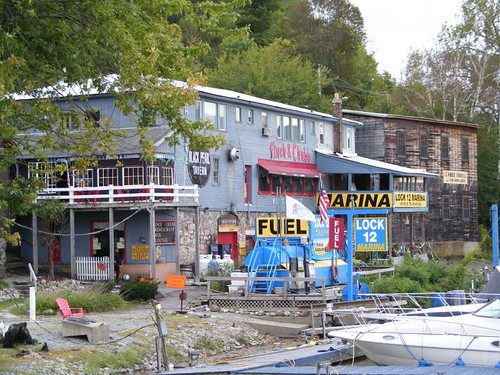
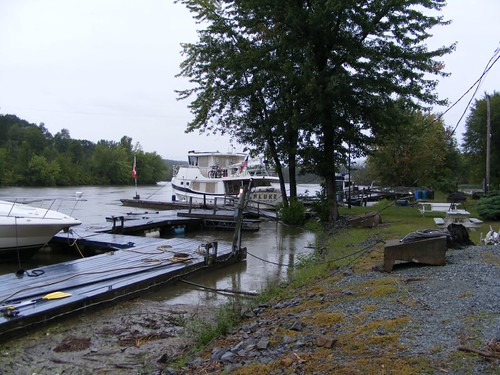
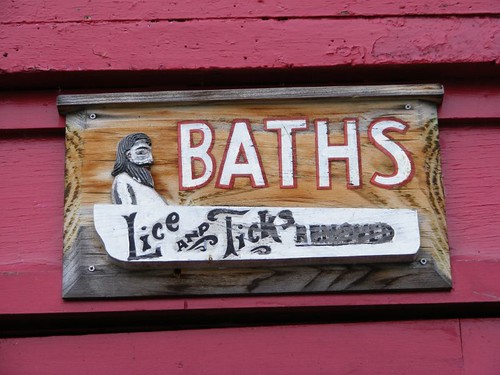
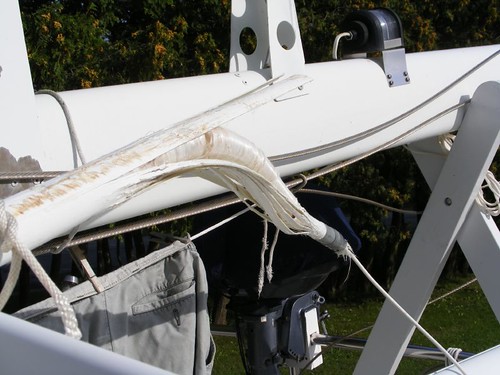
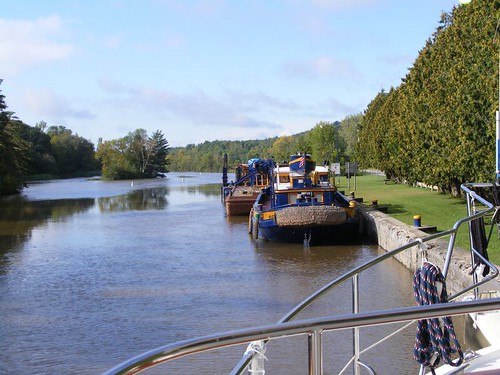


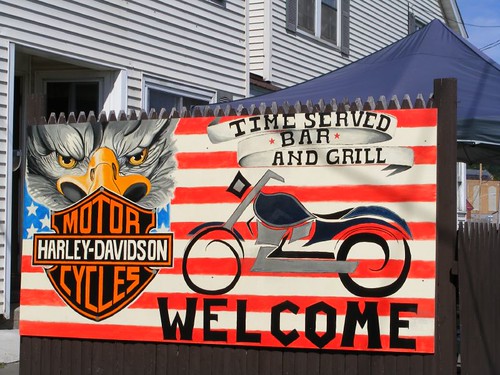
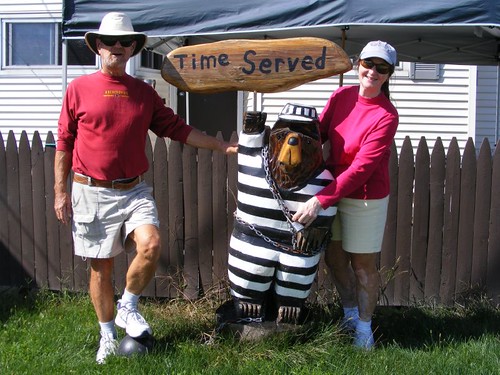








Please post the "Before the flogging" and "After the flogging" pictures, as a deterrent. (Please advise if this was a keel-hauling or walk-the-plank worthy offense.) Thanks!
ReplyDeletehandymanalex